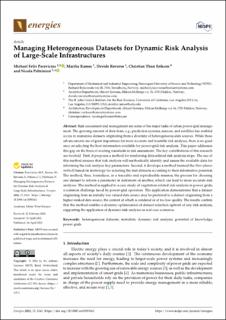| dc.contributor.author | Pacevicius, Michael Felix | |
| dc.contributor.author | Ramos, Marilia Abilio | |
| dc.contributor.author | Roverso, Davide | |
| dc.contributor.author | Eriksen, Christian Thun | |
| dc.contributor.author | Paltrinieri, Nicola | |
| dc.date.accessioned | 2023-03-07T09:15:13Z | |
| dc.date.available | 2023-03-07T09:15:13Z | |
| dc.date.created | 2022-10-18T14:19:52Z | |
| dc.date.issued | 2022 | |
| dc.identifier.citation | Energies. 2022, 15 (9), . | en_US |
| dc.identifier.issn | 1996-1073 | |
| dc.identifier.uri | https://hdl.handle.net/11250/3056314 | |
| dc.description.abstract | Risk assessment and management are some of the major tasks of urban power-grid management. The growing amount of data from, e.g., prediction systems, sensors, and satellites has enabled access to numerous datasets originating from a diversity of heterogeneous data sources. While these advancements are of great importance for more accurate and trustable risk analyses, there is no guidance on selecting the best information available for power-grid risk analysis. This paper addresses this gap on the basis of existing standards in risk assessment. The key contributions of this research are twofold. First, it proposes a method for reinforcing data-related risk analysis steps. The use of this method ensures that risk analysts will methodically identify and assess the available data for informing the risk analysis key parameters. Second, it develops a method (named the three-phases method) based on metrology for selecting the best datasets according to their informative potential. The method, thus, formalizes, in a traceable and reproducible manner, the process for choosing one dataset to inform a parameter in detriment of another, which can lead to more accurate risk analyses. The method is applied to a case study of vegetation-related risk analysis in power grids, a common challenge faced by power-grid operators. The application demonstrates that a dataset originating from an initially less valued data source may be preferred to a dataset originating from a higher-ranked data source, the content of which is outdated or of too low quality. The results confirm that the method enables a dynamic optimization of dataset selection upfront of any risk analysis, supporting the application of dynamic risk analyses in real-case scenarios. | en_US |
| dc.language.iso | eng | en_US |
| dc.publisher | MDPI | en_US |
| dc.rights | Navngivelse 4.0 Internasjonal | * |
| dc.rights.uri | http://creativecommons.org/licenses/by/4.0/deed.no | * |
| dc.title | Managing Heterogeneous Datasets for Dynamic Risk Analysis of Large-Scale Infrastructures | en_US |
| dc.title.alternative | Managing Heterogeneous Datasets for Dynamic Risk Analysis of Large-Scale Infrastructures | en_US |
| dc.type | Peer reviewed | en_US |
| dc.type | Journal article | en_US |
| dc.description.version | publishedVersion | en_US |
| dc.source.volume | 15 | en_US |
| dc.source.journal | Energies | en_US |
| dc.source.issue | 9 | en_US |
| dc.identifier.doi | 10.3390/en15093161 | |
| dc.identifier.cristin | 2062431 | |
| cristin.ispublished | true | |
| cristin.fulltext | original | |
| cristin.qualitycode | 1 | |

